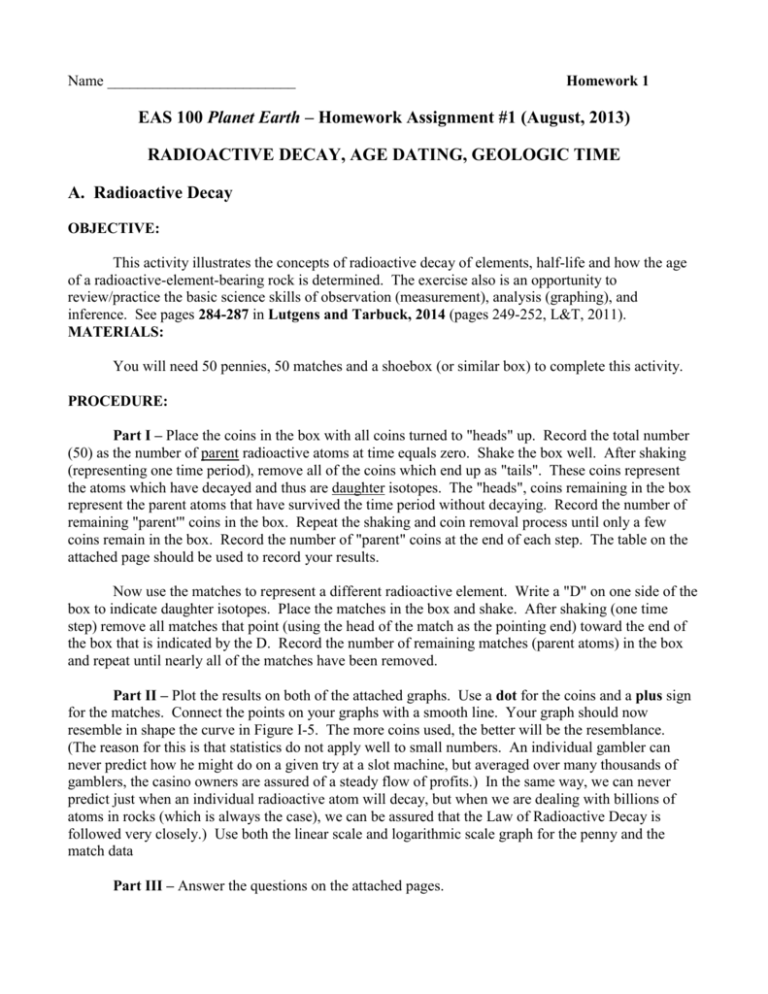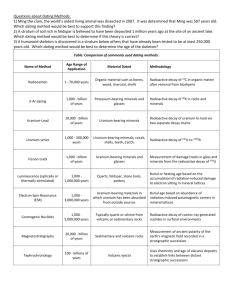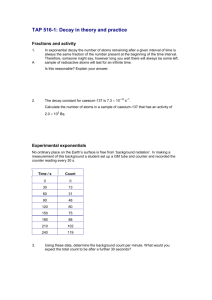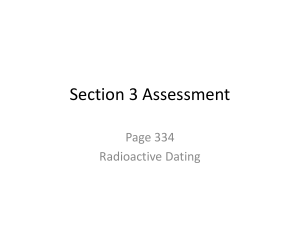Homework1
advertisement

Name _________________________ Homework 1 EAS 100 Planet Earth – Homework Assignment #1 (August, 2013) RADIOACTIVE DECAY, AGE DATING, GEOLOGIC TIME A. Radioactive Decay OBJECTIVE: This activity illustrates the concepts of radioactive decay of elements, half-life and how the age of a radioactive-element-bearing rock is determined. The exercise also is an opportunity to review/practice the basic science skills of observation (measurement), analysis (graphing), and inference. See pages 284-287 in Lutgens and Tarbuck, 2014 (pages 249-252, L&T, 2011). MATERIALS: You will need 50 pennies, 50 matches and a shoebox (or similar box) to complete this activity. PROCEDURE: Part I – Place the coins in the box with all coins turned to "heads" up. Record the total number (50) as the number of parent radioactive atoms at time equals zero. Shake the box well. After shaking (representing one time period), remove all of the coins which end up as "tails". These coins represent the atoms which have decayed and thus are daughter isotopes. The "heads", coins remaining in the box represent the parent atoms that have survived the time period without decaying. Record the number of remaining "parent'" coins in the box. Repeat the shaking and coin removal process until only a few coins remain in the box. Record the number of "parent" coins at the end of each step. The table on the attached page should be used to record your results. Now use the matches to represent a different radioactive element. Write a "D" on one side of the box to indicate daughter isotopes. Place the matches in the box and shake. After shaking (one time step) remove all matches that point (using the head of the match as the pointing end) toward the end of the box that is indicated by the D. Record the number of remaining matches (parent atoms) in the box and repeat until nearly all of the matches have been removed. Part II – Plot the results on both of the attached graphs. Use a dot for the coins and a plus sign for the matches. Connect the points on your graphs with a smooth line. Your graph should now resemble in shape the curve in Figure I-5. The more coins used, the better will be the resemblance. (The reason for this is that statistics do not apply well to small numbers. An individual gambler can never predict how he might do on a given try at a slot machine, but averaged over many thousands of gamblers, the casino owners are assured of a steady flow of profits.) In the same way, we can never predict just when an individual radioactive atom will decay, but when we are dealing with billions of atoms in rocks (which is always the case), we can be assured that the Law of Radioactive Decay is followed very closely.) Use both the linear scale and logarithmic scale graph for the penny and the match data Part III – Answer the questions on the attached pages. 2 EAS 100 – Homework #1 – Data and Graphs RADIOACTIVE DECAY Name _________________________ DATA TABLE: Number of "Time Intervals" 0 Parent "Atoms" Remaining Penny Match 50 50 1 2 3 4 5 6 QUESTIONS: A1. Which element, "match" or "penny" decays faster? Why? A2. What is the half-life for the "penny" element and for the "match" element in terms of number of time periods (shaking cycles)? 3 EAS 100 – Homework Assignment #1 - Graphs RADIOACTIVE DECAY Name _________________________ 4 Refer to pages 284-287 in Lutgens and Tarbuck 2014 – section on radioactive decay and radiometric dating (pages 249-252, L&T, 2011). A3. What is radioactivity? A4. Define Half-Life. A5. Examine Figure 8.19 – Radioactive decay curve, L&T, 2014 (Figure 8.16, L&T, 2011). How old (in number of half-lives) is a rock sample that has a radioactive isotope in which there is ~87% of the daughter product of the isotope and ~13% of the parent material of the isotope? B. Age Dating Refer to pages 274-283 in L&T 2014 – section on relative dating and fossil correlation (pages 238-239, L&T, 2011) and the Lecture Notes Figures handout number 1A. B1. Examine Figure 8.5 – Cross-cutting relationships, L&T, 2011 (There is no equivalent Figure in L&T, 2014 but you can access the Figure at: http://web.ics.purdue.edu/~braile/eas100/figure8.5.doc). Is the shale layer older than or younger than the conglomerate layer? What relative dating principle is used in your answer? Is Fault A older than or younger than Dike A? What relative dating principle is used in your answer? B2. Examine Figure 8.11 – Grand Canyon cross section, L&T, 2014 (Figure 8.7, L&T, 2011). Are the Bright Angel shale and Tapeats sandstones older than or younger than the Unkar Group sedimentary rocks? Explain why the Unkar Group sedimentary rocks are tilted (dipping layers) although the overlying Tapeats and Bright Angel sedimentary rocks are flat-lying. C. Geologic Time Refer to pages 287-289 in L&T, 2014 – section on geologic time scale (pages 252-255, L&T, 2011). C1. Examine the Geologic Time Scale in Figure 8.22, L&T, 2014 (Figure 8.18, L&T, 2011). What are the approximate ages of the following boundaries (the age that separates the Eras listed below)? Cenozoic/Mesozoic boundary: ________ Paleozoic/PreCambrian boundary: ________ Mesozoic/Paleozoic boundary: ________







